THE MODERNITY OF TARSILA DO AMARAL TAKES OVER THE GUGGENHEIM IN BILBAO
The Guggenheim Museum Bilbao hosts a retrospective exhibition of Tarsila do Amaral (Capivari, Brazil, 1886 - São Paulo, Brazil, 1973) focused on her conception and renovation of painting, as well as on her recognition as one of the key and most representative figures of the entry of avant-garde and modernizing pictorial languages in Latin America. A central name in Brazilian modernism, her style was consecrated as her own identity, a product of her desires and experiences, evoking both indigenous themes and the modernizing processes of a Brazil that was undergoing a constant transformation.
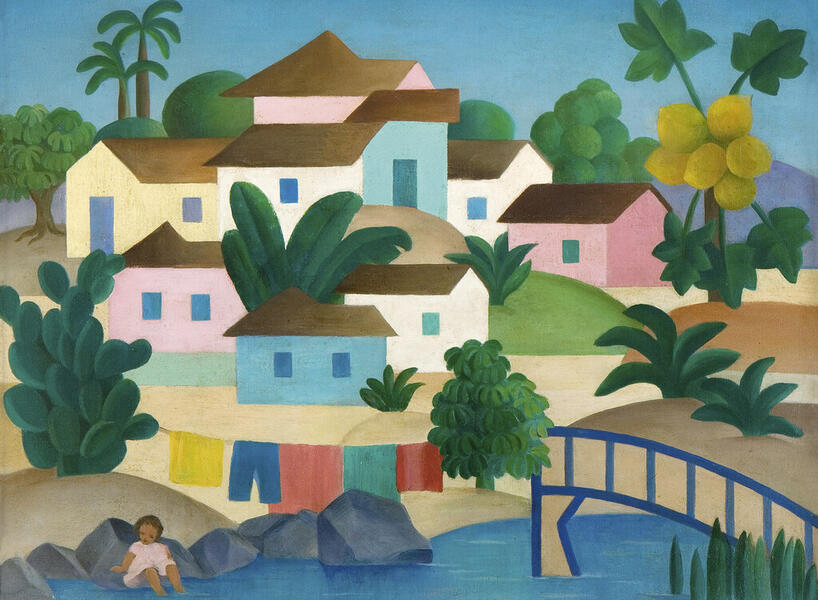
Tarsila do Amaral. Painting Modern Brazil traces the vital and artistic milestones of the Brazilian artist, analyzing the critical importance of her stay in Paris in the 1920s and her exposure to the avant-garde movements of cubism and primitivism, both fundamental in her syncretic proposal of themes and techniques to begin to create a universe of expression that was specific to her environment and interests with the aspiration to modernize and recognize, in that bridge that was, the historical relationships, anthropology and industrialization.
Although her critical attitude with certain avant-garde processes contrasts and contrasts interests of eminent Brazilian character, this was fundamental in the development of the concept and the matrix of much of her proposal. The distance in Europe will allow her to reconnect in another way, allowing her to integrate her origins in the pictorial evolution and in the birth of this new landscape rethinking.
-
Tarsila do Amaral en Guggenheim Bilbao
-
Tarsila do Amaral en Guggenheim Bilbao
-
Tarsila do Amaral en Guggenheim Bilbao
-
Tarsila do Amaral en Guggenheim Bilbao
-
Tarsila do Amaral en Guggenheim Bilbao
-
Tarsila do Amaral en Guggenheim Bilbao
-
Tarsila do Amaral en Guggenheim Bilbao
-
Tarsila do Amaral en Guggenheim Bilbao
São Paulo, Rio de Janeiro or rural Minas Gerais will be immortalized with lines and geometric shapes to consolidate her vision and consecrate a new imaginary that can respond both to her concerns and to external demands and that will derive, later, in a certain symbolism rooted in that Anthropophagic Movement that is key in the development of the avant-garde in Brazil.
The exhibition offers also, through the selection of works, a profound reading of a specific period that not only changed socially and economically, but also affected Tarsila do Amaral's possibilities for artistic development, trapped between the realities of decades of upheaval, her exposure to Marxist ideology and social realism, and the production that, as a witness, she managed to capture with aesthetic criteria and testimony.
Tarsila do Amaral. Painting Modern Brazil is on view through June 1 at the Guggenheim Museum Bilbao, Abandoibarra Etorbidea, 2, Bilbao (Spain).
May interest you
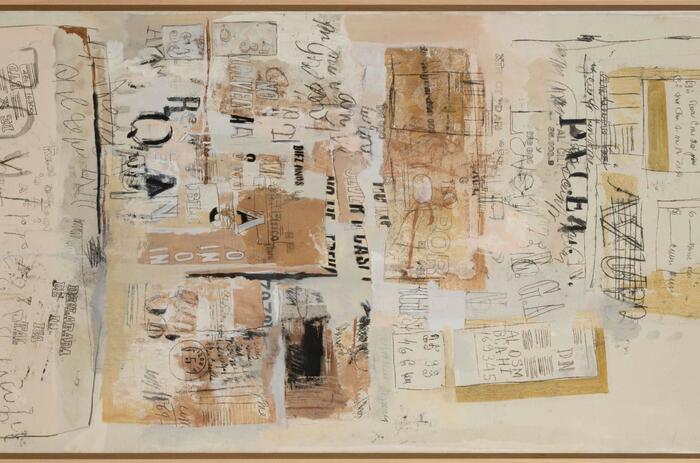
Madrid-based Maisterravalbuena proposes a vindication of the work of Sarah Grilo (Buenos Aires, Argentina,1917 - Madrid, Spain, 2007) through Soluciones para pensar, the second exhibition on this artist at the gallery. With a didactic and rediscovery vocation, the exhibition gathers a selection of paintings in different formats made between the 1960s and 1990s, many of them unpublished to the public. This work of selection and direct work of the gallery with the archive and the legacy of the Argentinean artist becomes fundamental in the structuring of the objective of creating opportunities for a greater knowledge of Grilo's work.
(RE)DISCOVERING SARAH GRILO AT MAISTERRAVALBUENA
Madrid-based Maisterravalbuena proposes a vindication of the work of Sarah Grilo (Buenos Aires, Argentina,1917 - Madrid, Spain, 2007) through Soluciones para pensar, the second exhibition on this artist at the gallery. With a didactic and rediscovery vocation, the exhibition gathers a selection of paintings in different formats made between the 1960s and 1990s, many of them unpublished to the public. This work of selection and direct work of the gallery with the archive and the legacy of the Argentinean artist becomes fundamental in the structuring of the objective of creating opportunities for a greater knowledge of Grilo's work.

Madrid-based Maisterravalbuena proposes a vindication of the work of Sarah Grilo (Buenos Aires, Argentina,1917 - Madrid, Spain, 2007) through Soluciones para pensar, the second exhibition on this artist at the gallery. With a didactic and rediscovery vocation, the exhibition gathers a selection of paintings in different formats made between the 1960s and 1990s, many of them unpublished to the public. This work of selection and direct work of the gallery with the archive and the legacy of the Argentinean artist becomes fundamental in the structuring of the objective of creating opportunities for a greater knowledge of Grilo's work.
(RE)DISCOVERING SARAH GRILO AT MAISTERRAVALBUENA
Madrid-based Maisterravalbuena proposes a vindication of the work of Sarah Grilo (Buenos Aires, Argentina,1917 - Madrid, Spain, 2007) through Soluciones para pensar, the second exhibition on this artist at the gallery. With a didactic and rediscovery vocation, the exhibition gathers a selection of paintings in different formats made between the 1960s and 1990s, many of them unpublished to the public. This work of selection and direct work of the gallery with the archive and the legacy of the Argentinean artist becomes fundamental in the structuring of the objective of creating opportunities for a greater knowledge of Grilo's work.
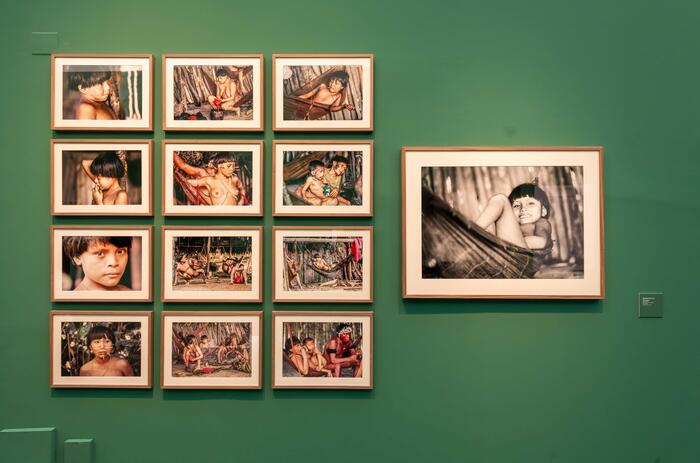
Madrid's CentroCentro approaches the artistic production related to the Amazon with the exhibition Trópico sin tópico: Amazonas (Tropic without Topic: Amazon), curated by Halim Badawi (Barranquilla, Colombia, 1982), and with which it intends to facilitate new looks beyond the usual ones with which the European imaginary contemplates the indigenous legacy and its relation with the contemporary world.
THE REVERSION OF AMAZONIAN CLICHÉS AT CENTROCENTRO
Madrid's CentroCentro approaches the artistic production related to the Amazon with the exhibition Trópico sin tópico: Amazonas (Tropic without Topic: Amazon), curated by Halim Badawi (Barranquilla, Colombia, 1982), and with which it intends to facilitate new looks beyond the usual ones with which the European imaginary contemplates the indigenous legacy and its relation with the contemporary world.
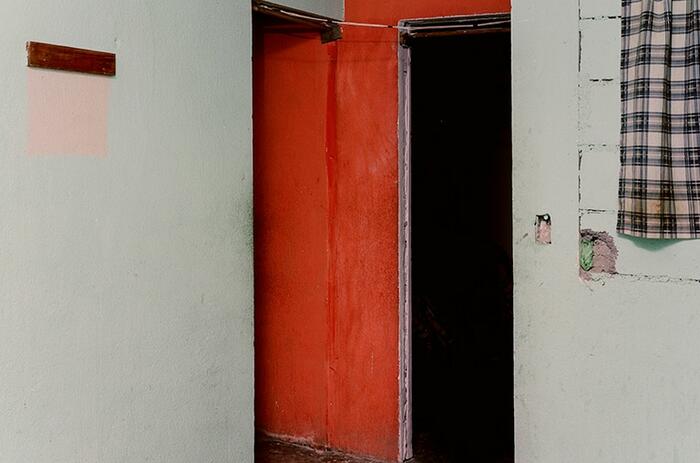
Felipe Romero (Bogota, Colombia, 1992) usually shows in his photographic proposal a high interest in conflict zones. While the scenario reflects this palpable but still intangible tension, it also serves as a reflective framework where the conflict and its protagonists meet.
BORDER HOPELESSNESS THROUGH THE LENS OF FELIPE ROMERO
Felipe Romero (Bogota, Colombia, 1992) usually shows in his photographic proposal a high interest in conflict zones. While the scenario reflects this palpable but still intangible tension, it also serves as a reflective framework where the conflict and its protagonists meet.

The Hochschild Correa Collection boasts of being the most complete private collection of contemporary art from the Peruvian Amazon. Nevertheless, for more than a decade, it has been built on a varied and unrestricted collection, which has made it possible to bring together the different trends and techniques currently being used in the region, with a focus on dialogue and a certain relational patina among the works that make up the collection.
PERUVIAN AMAZONIAN ART THROUGH THE HOCHSCHILD CORREA COLLECTION
The Hochschild Correa Collection boasts of being the most complete private collection of contemporary art from the Peruvian Amazon. Nevertheless, for more than a decade, it has been built on a varied and unrestricted collection, which has made it possible to bring together the different trends and techniques currently being used in the region, with a focus on dialogue and a certain relational patina among the works that make up the collection.

The Badischer Kunstverein presents the work of the Brazilian poet and artist in their first extensive solo exhibition in Germany; To See Aloud includes diverse facets of her artistic practice, ranging from early text works, videotext poems, publications and printed matter to photographs, objects, object poems and installations, all the way to her most recent performances and artworks in public spaces, including sound-based and collective activations.
LENORA DE BARROS' EXHIBITION, A MULTISENSORIAL EXPERIENCE
The Badischer Kunstverein presents the work of the Brazilian poet and artist in their first extensive solo exhibition in Germany; To See Aloud includes diverse facets of her artistic practice, ranging from early text works, videotext poems, publications and printed matter to photographs, objects, object poems and installations, all the way to her most recent performances and artworks in public spaces, including sound-based and collective activations.
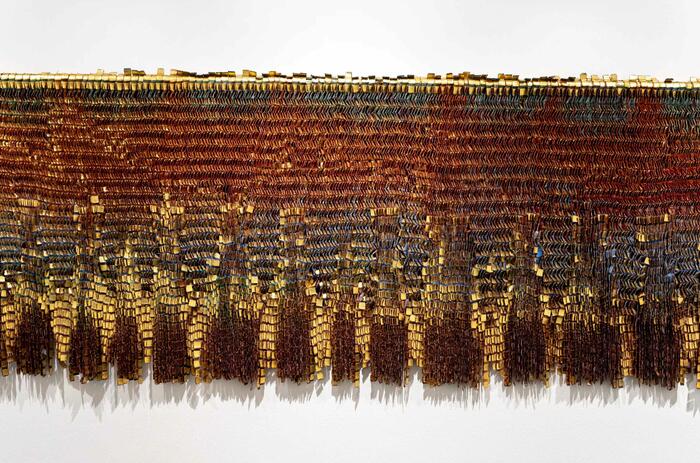
The Institute of Contemporary Art Miami (ICA Miami) presents a retrospective of textile artist Olga de Amaral (Bogotá, 1932), a pioneer in material exploration and the expansion of textile art. The exhibition, in collaboration with the Fondation Cartier pour l’art contemporain in Paris, will be open from May 1 to October 12, showcasing over 50 works spanning six decades of her career, including pieces never before exhibited outside Colombia.
AMARAL IN MIAMI: A JOURNEY THROUGH 60 YEARS OF ARTISTIC EVOLUTION
The Institute of Contemporary Art Miami (ICA Miami) presents a retrospective of textile artist Olga de Amaral (Bogotá, 1932), a pioneer in material exploration and the expansion of textile art. The exhibition, in collaboration with the Fondation Cartier pour l’art contemporain in Paris, will be open from May 1 to October 12, showcasing over 50 works spanning six decades of her career, including pieces never before exhibited outside Colombia.

Madrid-based Maisterravalbuena proposes a vindication of the work of Sarah Grilo (Buenos Aires, Argentina,1917 - Madrid, Spain, 2007) through Soluciones para pensar, the second exhibition on this artist at the gallery. With a didactic and rediscovery vocation, the exhibition gathers a selection of paintings in different formats made between the 1960s and 1990s, many of them unpublished to the public. This work of selection and direct work of the gallery with the archive and the legacy of the Argentinean artist becomes fundamental in the structuring of the objective of creating opportunities for a greater knowledge of Grilo's work.
(RE)DISCOVERING SARAH GRILO AT MAISTERRAVALBUENA
Madrid-based Maisterravalbuena proposes a vindication of the work of Sarah Grilo (Buenos Aires, Argentina,1917 - Madrid, Spain, 2007) through Soluciones para pensar, the second exhibition on this artist at the gallery. With a didactic and rediscovery vocation, the exhibition gathers a selection of paintings in different formats made between the 1960s and 1990s, many of them unpublished to the public. This work of selection and direct work of the gallery with the archive and the legacy of the Argentinean artist becomes fundamental in the structuring of the objective of creating opportunities for a greater knowledge of Grilo's work.

Madrid's CentroCentro approaches the artistic production related to the Amazon with the exhibition Trópico sin tópico: Amazonas (Tropic without Topic: Amazon), curated by Halim Badawi (Barranquilla, Colombia, 1982), and with which it intends to facilitate new looks beyond the usual ones with which the European imaginary contemplates the indigenous legacy and its relation with the contemporary world.
THE REVERSION OF AMAZONIAN CLICHÉS AT CENTROCENTRO
Madrid's CentroCentro approaches the artistic production related to the Amazon with the exhibition Trópico sin tópico: Amazonas (Tropic without Topic: Amazon), curated by Halim Badawi (Barranquilla, Colombia, 1982), and with which it intends to facilitate new looks beyond the usual ones with which the European imaginary contemplates the indigenous legacy and its relation with the contemporary world.

Felipe Romero (Bogota, Colombia, 1992) usually shows in his photographic proposal a high interest in conflict zones. While the scenario reflects this palpable but still intangible tension, it also serves as a reflective framework where the conflict and its protagonists meet.
BORDER HOPELESSNESS THROUGH THE LENS OF FELIPE ROMERO
Felipe Romero (Bogota, Colombia, 1992) usually shows in his photographic proposal a high interest in conflict zones. While the scenario reflects this palpable but still intangible tension, it also serves as a reflective framework where the conflict and its protagonists meet.

The Hochschild Correa Collection boasts of being the most complete private collection of contemporary art from the Peruvian Amazon. Nevertheless, for more than a decade, it has been built on a varied and unrestricted collection, which has made it possible to bring together the different trends and techniques currently being used in the region, with a focus on dialogue and a certain relational patina among the works that make up the collection.
PERUVIAN AMAZONIAN ART THROUGH THE HOCHSCHILD CORREA COLLECTION
The Hochschild Correa Collection boasts of being the most complete private collection of contemporary art from the Peruvian Amazon. Nevertheless, for more than a decade, it has been built on a varied and unrestricted collection, which has made it possible to bring together the different trends and techniques currently being used in the region, with a focus on dialogue and a certain relational patina among the works that make up the collection.

The Badischer Kunstverein presents the work of the Brazilian poet and artist in their first extensive solo exhibition in Germany; To See Aloud includes diverse facets of her artistic practice, ranging from early text works, videotext poems, publications and printed matter to photographs, objects, object poems and installations, all the way to her most recent performances and artworks in public spaces, including sound-based and collective activations.
LENORA DE BARROS' EXHIBITION, A MULTISENSORIAL EXPERIENCE
The Badischer Kunstverein presents the work of the Brazilian poet and artist in their first extensive solo exhibition in Germany; To See Aloud includes diverse facets of her artistic practice, ranging from early text works, videotext poems, publications and printed matter to photographs, objects, object poems and installations, all the way to her most recent performances and artworks in public spaces, including sound-based and collective activations.

The Institute of Contemporary Art Miami (ICA Miami) presents a retrospective of textile artist Olga de Amaral (Bogotá, 1932), a pioneer in material exploration and the expansion of textile art. The exhibition, in collaboration with the Fondation Cartier pour l’art contemporain in Paris, will be open from May 1 to October 12, showcasing over 50 works spanning six decades of her career, including pieces never before exhibited outside Colombia.
AMARAL IN MIAMI: A JOURNEY THROUGH 60 YEARS OF ARTISTIC EVOLUTION
The Institute of Contemporary Art Miami (ICA Miami) presents a retrospective of textile artist Olga de Amaral (Bogotá, 1932), a pioneer in material exploration and the expansion of textile art. The exhibition, in collaboration with the Fondation Cartier pour l’art contemporain in Paris, will be open from May 1 to October 12, showcasing over 50 works spanning six decades of her career, including pieces never before exhibited outside Colombia.

Madrid-based Maisterravalbuena proposes a vindication of the work of Sarah Grilo (Buenos Aires, Argentina,1917 - Madrid, Spain, 2007) through Soluciones para pensar, the second exhibition on this artist at the gallery. With a didactic and rediscovery vocation, the exhibition gathers a selection of paintings in different formats made between the 1960s and 1990s, many of them unpublished to the public. This work of selection and direct work of the gallery with the archive and the legacy of the Argentinean artist becomes fundamental in the structuring of the objective of creating opportunities for a greater knowledge of Grilo's work.
(RE)DISCOVERING SARAH GRILO AT MAISTERRAVALBUENA
Madrid-based Maisterravalbuena proposes a vindication of the work of Sarah Grilo (Buenos Aires, Argentina,1917 - Madrid, Spain, 2007) through Soluciones para pensar, the second exhibition on this artist at the gallery. With a didactic and rediscovery vocation, the exhibition gathers a selection of paintings in different formats made between the 1960s and 1990s, many of them unpublished to the public. This work of selection and direct work of the gallery with the archive and the legacy of the Argentinean artist becomes fundamental in the structuring of the objective of creating opportunities for a greater knowledge of Grilo's work.

Madrid's CentroCentro approaches the artistic production related to the Amazon with the exhibition Trópico sin tópico: Amazonas (Tropic without Topic: Amazon), curated by Halim Badawi (Barranquilla, Colombia, 1982), and with which it intends to facilitate new looks beyond the usual ones with which the European imaginary contemplates the indigenous legacy and its relation with the contemporary world.
THE REVERSION OF AMAZONIAN CLICHÉS AT CENTROCENTRO
Madrid's CentroCentro approaches the artistic production related to the Amazon with the exhibition Trópico sin tópico: Amazonas (Tropic without Topic: Amazon), curated by Halim Badawi (Barranquilla, Colombia, 1982), and with which it intends to facilitate new looks beyond the usual ones with which the European imaginary contemplates the indigenous legacy and its relation with the contemporary world.

Felipe Romero (Bogota, Colombia, 1992) usually shows in his photographic proposal a high interest in conflict zones. While the scenario reflects this palpable but still intangible tension, it also serves as a reflective framework where the conflict and its protagonists meet.
BORDER HOPELESSNESS THROUGH THE LENS OF FELIPE ROMERO
Felipe Romero (Bogota, Colombia, 1992) usually shows in his photographic proposal a high interest in conflict zones. While the scenario reflects this palpable but still intangible tension, it also serves as a reflective framework where the conflict and its protagonists meet.

The Hochschild Correa Collection boasts of being the most complete private collection of contemporary art from the Peruvian Amazon. Nevertheless, for more than a decade, it has been built on a varied and unrestricted collection, which has made it possible to bring together the different trends and techniques currently being used in the region, with a focus on dialogue and a certain relational patina among the works that make up the collection.
PERUVIAN AMAZONIAN ART THROUGH THE HOCHSCHILD CORREA COLLECTION
The Hochschild Correa Collection boasts of being the most complete private collection of contemporary art from the Peruvian Amazon. Nevertheless, for more than a decade, it has been built on a varied and unrestricted collection, which has made it possible to bring together the different trends and techniques currently being used in the region, with a focus on dialogue and a certain relational patina among the works that make up the collection.

The Badischer Kunstverein presents the work of the Brazilian poet and artist in their first extensive solo exhibition in Germany; To See Aloud includes diverse facets of her artistic practice, ranging from early text works, videotext poems, publications and printed matter to photographs, objects, object poems and installations, all the way to her most recent performances and artworks in public spaces, including sound-based and collective activations.
LENORA DE BARROS' EXHIBITION, A MULTISENSORIAL EXPERIENCE
The Badischer Kunstverein presents the work of the Brazilian poet and artist in their first extensive solo exhibition in Germany; To See Aloud includes diverse facets of her artistic practice, ranging from early text works, videotext poems, publications and printed matter to photographs, objects, object poems and installations, all the way to her most recent performances and artworks in public spaces, including sound-based and collective activations.

The Institute of Contemporary Art Miami (ICA Miami) presents a retrospective of textile artist Olga de Amaral (Bogotá, 1932), a pioneer in material exploration and the expansion of textile art. The exhibition, in collaboration with the Fondation Cartier pour l’art contemporain in Paris, will be open from May 1 to October 12, showcasing over 50 works spanning six decades of her career, including pieces never before exhibited outside Colombia.
AMARAL IN MIAMI: A JOURNEY THROUGH 60 YEARS OF ARTISTIC EVOLUTION
The Institute of Contemporary Art Miami (ICA Miami) presents a retrospective of textile artist Olga de Amaral (Bogotá, 1932), a pioneer in material exploration and the expansion of textile art. The exhibition, in collaboration with the Fondation Cartier pour l’art contemporain in Paris, will be open from May 1 to October 12, showcasing over 50 works spanning six decades of her career, including pieces never before exhibited outside Colombia.

Madrid-based Maisterravalbuena proposes a vindication of the work of Sarah Grilo (Buenos Aires, Argentina,1917 - Madrid, Spain, 2007) through Soluciones para pensar, the second exhibition on this artist at the gallery. With a didactic and rediscovery vocation, the exhibition gathers a selection of paintings in different formats made between the 1960s and 1990s, many of them unpublished to the public. This work of selection and direct work of the gallery with the archive and the legacy of the Argentinean artist becomes fundamental in the structuring of the objective of creating opportunities for a greater knowledge of Grilo's work.
(RE)DISCOVERING SARAH GRILO AT MAISTERRAVALBUENA
Madrid-based Maisterravalbuena proposes a vindication of the work of Sarah Grilo (Buenos Aires, Argentina,1917 - Madrid, Spain, 2007) through Soluciones para pensar, the second exhibition on this artist at the gallery. With a didactic and rediscovery vocation, the exhibition gathers a selection of paintings in different formats made between the 1960s and 1990s, many of them unpublished to the public. This work of selection and direct work of the gallery with the archive and the legacy of the Argentinean artist becomes fundamental in the structuring of the objective of creating opportunities for a greater knowledge of Grilo's work.

Madrid's CentroCentro approaches the artistic production related to the Amazon with the exhibition Trópico sin tópico: Amazonas (Tropic without Topic: Amazon), curated by Halim Badawi (Barranquilla, Colombia, 1982), and with which it intends to facilitate new looks beyond the usual ones with which the European imaginary contemplates the indigenous legacy and its relation with the contemporary world.
THE REVERSION OF AMAZONIAN CLICHÉS AT CENTROCENTRO
Madrid's CentroCentro approaches the artistic production related to the Amazon with the exhibition Trópico sin tópico: Amazonas (Tropic without Topic: Amazon), curated by Halim Badawi (Barranquilla, Colombia, 1982), and with which it intends to facilitate new looks beyond the usual ones with which the European imaginary contemplates the indigenous legacy and its relation with the contemporary world.

Felipe Romero (Bogota, Colombia, 1992) usually shows in his photographic proposal a high interest in conflict zones. While the scenario reflects this palpable but still intangible tension, it also serves as a reflective framework where the conflict and its protagonists meet.
BORDER HOPELESSNESS THROUGH THE LENS OF FELIPE ROMERO
Felipe Romero (Bogota, Colombia, 1992) usually shows in his photographic proposal a high interest in conflict zones. While the scenario reflects this palpable but still intangible tension, it also serves as a reflective framework where the conflict and its protagonists meet.

The Hochschild Correa Collection boasts of being the most complete private collection of contemporary art from the Peruvian Amazon. Nevertheless, for more than a decade, it has been built on a varied and unrestricted collection, which has made it possible to bring together the different trends and techniques currently being used in the region, with a focus on dialogue and a certain relational patina among the works that make up the collection.
PERUVIAN AMAZONIAN ART THROUGH THE HOCHSCHILD CORREA COLLECTION
The Hochschild Correa Collection boasts of being the most complete private collection of contemporary art from the Peruvian Amazon. Nevertheless, for more than a decade, it has been built on a varied and unrestricted collection, which has made it possible to bring together the different trends and techniques currently being used in the region, with a focus on dialogue and a certain relational patina among the works that make up the collection.

The Badischer Kunstverein presents the work of the Brazilian poet and artist in their first extensive solo exhibition in Germany; To See Aloud includes diverse facets of her artistic practice, ranging from early text works, videotext poems, publications and printed matter to photographs, objects, object poems and installations, all the way to her most recent performances and artworks in public spaces, including sound-based and collective activations.
LENORA DE BARROS' EXHIBITION, A MULTISENSORIAL EXPERIENCE
The Badischer Kunstverein presents the work of the Brazilian poet and artist in their first extensive solo exhibition in Germany; To See Aloud includes diverse facets of her artistic practice, ranging from early text works, videotext poems, publications and printed matter to photographs, objects, object poems and installations, all the way to her most recent performances and artworks in public spaces, including sound-based and collective activations.

The Institute of Contemporary Art Miami (ICA Miami) presents a retrospective of textile artist Olga de Amaral (Bogotá, 1932), a pioneer in material exploration and the expansion of textile art. The exhibition, in collaboration with the Fondation Cartier pour l’art contemporain in Paris, will be open from May 1 to October 12, showcasing over 50 works spanning six decades of her career, including pieces never before exhibited outside Colombia.
AMARAL IN MIAMI: A JOURNEY THROUGH 60 YEARS OF ARTISTIC EVOLUTION
The Institute of Contemporary Art Miami (ICA Miami) presents a retrospective of textile artist Olga de Amaral (Bogotá, 1932), a pioneer in material exploration and the expansion of textile art. The exhibition, in collaboration with the Fondation Cartier pour l’art contemporain in Paris, will be open from May 1 to October 12, showcasing over 50 works spanning six decades of her career, including pieces never before exhibited outside Colombia.

Madrid-based Maisterravalbuena proposes a vindication of the work of Sarah Grilo (Buenos Aires, Argentina,1917 - Madrid, Spain, 2007) through Soluciones para pensar, the second exhibition on this artist at the gallery. With a didactic and rediscovery vocation, the exhibition gathers a selection of paintings in different formats made between the 1960s and 1990s, many of them unpublished to the public. This work of selection and direct work of the gallery with the archive and the legacy of the Argentinean artist becomes fundamental in the structuring of the objective of creating opportunities for a greater knowledge of Grilo's work.
(RE)DISCOVERING SARAH GRILO AT MAISTERRAVALBUENA
Madrid-based Maisterravalbuena proposes a vindication of the work of Sarah Grilo (Buenos Aires, Argentina,1917 - Madrid, Spain, 2007) through Soluciones para pensar, the second exhibition on this artist at the gallery. With a didactic and rediscovery vocation, the exhibition gathers a selection of paintings in different formats made between the 1960s and 1990s, many of them unpublished to the public. This work of selection and direct work of the gallery with the archive and the legacy of the Argentinean artist becomes fundamental in the structuring of the objective of creating opportunities for a greater knowledge of Grilo's work.

Madrid's CentroCentro approaches the artistic production related to the Amazon with the exhibition Trópico sin tópico: Amazonas (Tropic without Topic: Amazon), curated by Halim Badawi (Barranquilla, Colombia, 1982), and with which it intends to facilitate new looks beyond the usual ones with which the European imaginary contemplates the indigenous legacy and its relation with the contemporary world.
THE REVERSION OF AMAZONIAN CLICHÉS AT CENTROCENTRO
Madrid's CentroCentro approaches the artistic production related to the Amazon with the exhibition Trópico sin tópico: Amazonas (Tropic without Topic: Amazon), curated by Halim Badawi (Barranquilla, Colombia, 1982), and with which it intends to facilitate new looks beyond the usual ones with which the European imaginary contemplates the indigenous legacy and its relation with the contemporary world.

Felipe Romero (Bogota, Colombia, 1992) usually shows in his photographic proposal a high interest in conflict zones. While the scenario reflects this palpable but still intangible tension, it also serves as a reflective framework where the conflict and its protagonists meet.
BORDER HOPELESSNESS THROUGH THE LENS OF FELIPE ROMERO
Felipe Romero (Bogota, Colombia, 1992) usually shows in his photographic proposal a high interest in conflict zones. While the scenario reflects this palpable but still intangible tension, it also serves as a reflective framework where the conflict and its protagonists meet.

The Hochschild Correa Collection boasts of being the most complete private collection of contemporary art from the Peruvian Amazon. Nevertheless, for more than a decade, it has been built on a varied and unrestricted collection, which has made it possible to bring together the different trends and techniques currently being used in the region, with a focus on dialogue and a certain relational patina among the works that make up the collection.
PERUVIAN AMAZONIAN ART THROUGH THE HOCHSCHILD CORREA COLLECTION
The Hochschild Correa Collection boasts of being the most complete private collection of contemporary art from the Peruvian Amazon. Nevertheless, for more than a decade, it has been built on a varied and unrestricted collection, which has made it possible to bring together the different trends and techniques currently being used in the region, with a focus on dialogue and a certain relational patina among the works that make up the collection.

The Badischer Kunstverein presents the work of the Brazilian poet and artist in their first extensive solo exhibition in Germany; To See Aloud includes diverse facets of her artistic practice, ranging from early text works, videotext poems, publications and printed matter to photographs, objects, object poems and installations, all the way to her most recent performances and artworks in public spaces, including sound-based and collective activations.
LENORA DE BARROS' EXHIBITION, A MULTISENSORIAL EXPERIENCE
The Badischer Kunstverein presents the work of the Brazilian poet and artist in their first extensive solo exhibition in Germany; To See Aloud includes diverse facets of her artistic practice, ranging from early text works, videotext poems, publications and printed matter to photographs, objects, object poems and installations, all the way to her most recent performances and artworks in public spaces, including sound-based and collective activations.

The Institute of Contemporary Art Miami (ICA Miami) presents a retrospective of textile artist Olga de Amaral (Bogotá, 1932), a pioneer in material exploration and the expansion of textile art. The exhibition, in collaboration with the Fondation Cartier pour l’art contemporain in Paris, will be open from May 1 to October 12, showcasing over 50 works spanning six decades of her career, including pieces never before exhibited outside Colombia.
AMARAL IN MIAMI: A JOURNEY THROUGH 60 YEARS OF ARTISTIC EVOLUTION
The Institute of Contemporary Art Miami (ICA Miami) presents a retrospective of textile artist Olga de Amaral (Bogotá, 1932), a pioneer in material exploration and the expansion of textile art. The exhibition, in collaboration with the Fondation Cartier pour l’art contemporain in Paris, will be open from May 1 to October 12, showcasing over 50 works spanning six decades of her career, including pieces never before exhibited outside Colombia.




